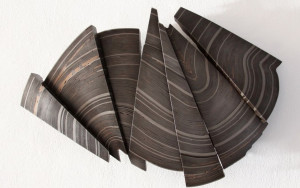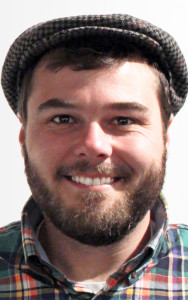
Located at the nexus of the Great Plains and the Rocky Mountains, Boulder’s topography is the ultimate geologic juxtaposition. The change of slope where the flat lands meet the Front Range offers a captivating contrast, but is also a source of some controversy. While geologists agree about the events that caused the initial uplift in Colorado’s continental crust, they disagree about the events that created the mountains that exist today.
The process spans millions of years with no human record to help geologists construct their theories. Instead, they must study the earth in hopes of uncovering the history captured in the rocks.
Standing apart from the crowd is Joshua Goss, a geologist by education but a blacksmith by trade, who makes geologic art in his metal shop in Denver. His sculptures, currently on exhibition in his show UPlift! at The Dairy Arts Center, create snapshots of the geologic process, capturing the processes of time, heat and pressure.
Inside his studio, Goss layers materials from the earth — iron, bronze, steel and thermoform plastic. He heats them to high temperatures and compresses them horizontally with a hydraulic press, causing the layers to bond much like the process of geological deposition.
After the layers mold together, Goss cuts into the straight layers, introducing fault lines into the block of metal and plastic. To recreate the process of orogeny — a scientific term for mountain building — Goss then reheats and compresses the piece, causing uplift and ductile distortion.
At this point, Goss has created a blackened and charred block of metal that is shredded, ripped and distorted. Goss says this in-between state makes him feel uncomfortable, compelling him to refine the piece to assuage his perfectionist tendencies.
Goss begins to cut the mutated block apart and then introduces erosive processes as he soaks each piece in an acid bath for several days, cleaning and adding luster to the metal. Having created individual pieces of a greater puzzle, Goss sets to rearrange them into a compelling visual story.

“What would take millions of years to make in nature, you are seeing happen right before your eyes,” Goss says. “It kind of puts the geological time scale in a human perspective, which is one of my goals in making this.”
The Rockies formed 70 million years ago as inward moving tectonic pressure at both coasts pushed up slabs of earth at weak areas in the middle of the continental crust, only to be covered with debris in the following millions of years. But scientists disagree about whether the Rockies that exist today are the result of a secondary uplift event or a series of massive erosion events caused by cooling climates.
Lon Abbott, professor of geology at the University of Colorado Boulder, is joining Goss for a lecture about art and geology at The Dairy on May 3 to talk about these different theories and the way geologists study the earth to find answers.
“If you go wandering in the foothills on your hike, the rocks are crying out to you with all kind of stories that you don’t notice,” Abbot says. “It’s just like if someone was talking to you in Greek but you don’t understand the language, so it’s in one ear and out the other. But if you understand the language, then all of the sudden you are learning all kinds of interesting things as you walk through a Greek town. So, as geologists we are basically telling that story, much like Josh is telling his story.”
The major difference between Goss’ artistry and scientific methodology isn’t process per se, but perspective. While the geologist is akin to a detective, reconstructing the clues of the crime scene into a logical narrative built around scientific evidence, the artist stands watch over the entirety of the process to express the underlying universal value. Goss is both.

Although he follows the tenets of the scientific method for experimentation in his artistic process, he says, “the great thing about art is that it doesn’t have to be extremely scientific.” This allows him a unique vantage point over a hidden process.
Just as the creation of the Rocky Mountains is seen differently by different geologists, so is the interpretation of art. Each tells a timeless story, one evidenced by the earth, the other by resonating with a human audience. The pairing of Goss’s sculpture with geologic history helps to make both more accessible and impactful.
On the Bill: Joshua Goss: UPlift! The Dairy Arts Center, 2590 Walnut St., Boulder, 303-440-7826.Through May 13. Gallery Opening Reception, Friday, April 22, 5 p.m. Artist and Scientist Lecture, featuring Joshua Goss and Lon Abbot, Tuesday, May 3, 7 p.m.














